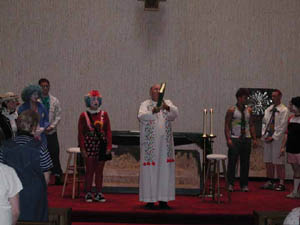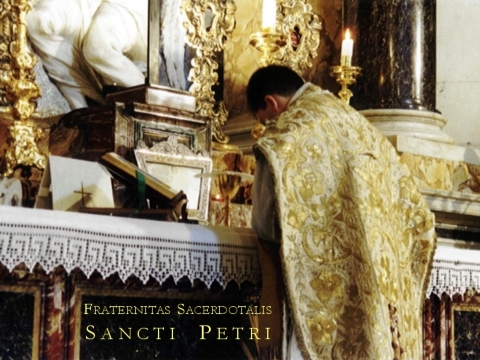OK, recently I have received a lot of complaints concerning the pictures I chose to depict the liturgical problems evident in our church, so here I will do some explaining on what I was trying to get across.
*Note, I'm not using the same pictures because that seems to be the source of the problem, I will use different pictures to get the point across.
Picture #1 The Mass according to the 1962 Missal:

OK, first off this picture may be from an SSPX website (I'm not sure), but regardless it can be used to show my point.
The first thing most people notice about this picture it the adorned altar. Truth be told, this is a relatively simple altar, however the presence of Christ is so strong and so evident at this Mass that the people who prepared for it literally gave their all to Jesus. Notice the finely laced altar cloth, the brass candle sticks, the presence of statues, the brass crucifix. Notice the posture of the priest, as well as the direction he's facing lead the people at the Mass to contemplate the crucifix and thus contemplate the very mystery of the Mass. All is centered on Christ. Notice the altar boy, reverently kneeling before the Lord, preparing to enter the mystery. I won't take the time to go into the actual Order of the Mass because I think the differences are plainly evident and don't need repeated here. Let's just focus on the aesthetics for a moment.
Picture #2 The Mass according to the Missal of 2000:

This picture shows your typical Mass according to the Missal of 2000 (a continuation in the tradition of the Missal of 1970).
So what's the first thing we notice here. OK first off we may notice that it seems to be celebrated somewhere besides a church. Let's ignore that fact for the moment, because its irrelevant to the way the Mass is celebrated. So, let's compare to some of the things we saw in the last picture.
Let's take a look at the adornments of the Altar. First the altar itself. It appears to be a cheap table that just about anybody can pick up at any retail or outlet store. The altar is decorated with two cheap candles left in their plastic tubes and an altar cloth that has the visual appeal of a bed sheet. Granted the flowers present are nice, but seem to throw off the symmetry of what we're looking at.
That brings us to our next point. Exactly what are we looking at? What is the focus here? Our first answer may very well be "Jesus," but we have to ask ourselves is that really true, and if it is true, does this Mass promote that focus. I would say it does not. The overwhelming object of focus here is the priest. To dabble into the Order of the Mass for just a bit, he says the canon allowed. This act alone makes him, and not the sacrifice he is performing, the center of attention. As I said before, though, let's leave the Order of the Mass aside. Focusing just on the aesthetics of the moment, what is there to contemplate? There is no crucifix on the altar. Now, canon law requires one to be near the altar, so I am assuming that one is there. However, because the crucifix is not in the picture, we can easily say that contemplation on the sacrifice of Jesus is, at best, placed to the side.
I want to point out one more thing that corrupts the aesthetics here that many people don't take into consideration. I want to highlight the presence of what appears to be 5 chalices on the altar. Now, I'm not intending to point out any doctrinal error or any violation of canon law. I can tell you that to the best of my knowledge the Mass in this picture is in perfect accordance with Canon law and the Roman Missal of 2000. I do, however, want to focus on the aesthetics here. With the presence of so many sacred vessels, probably because of all the concelebrating priests as well as the fact that they're probably giving communion under both species, it construes the focus of the Mass. I have heard it said by somebody that it seems like traditional Catholics, with our demands that sacred vessels be made of precious metals, worship the vessels more than what is contained therein. With an altar set up like this, it is no wonder somebody could come to such a conclusion. The overwhelming presence of sacred vessels on the altar seems to make them the center of focus, and not Christ, not the Holy Eucharist. It simply leaves the altar cluttered and unfocused.
I also want to put what I just said in context. I'm not saying that communion under both species is a bad thing. In and of itself it is not. I do think, however, we need to rethink how we perform the rite in preparation for such an act. i don't think it was well thought out, but I don't think it's necessarily incompatible with the Roman Liturgy. I will leave it at that.
Picture #3, The Clown Mass:

Because it was brought to my attention that the picture I posted in my previous post wasn't even a Catholic Mass (I would argue that this isn't a Catholic Mass either, but I will leave that aside) here are the facts on this picture.
This picture is of a "Mass" celebrated on Sept. 1 2002 at Christ the King Catholic Church, Pleasant Hill, Ca.
"But Zach, this is a liturgical abuse and not in any way sanctioned by the Church." This is what I imagine many of you are saying right now. I won't argue that this isn't a liturgical abuse. We all know what's wrong with this picture, so I don't even have to go into the aesthetics of it. So why did I post it?
I posted it for two reasons with two scopes. I posted a "Clown Mass" because it is the poster child for major liturgical abuse in the Catholic Church today. It is on the same level as "Barny Mass," "Life Teen Mass," "Charismatic Mass," "Gay Mass," and many other people oriented Masses. We can no longer have "Holy Mass" anymore. It has to be people oriented.
So why did I post a liturgically abusive Mass in the first place? Well, to answer that question, let's look at picture #2 again. What was the focus in picture #2? To make a long story short, we are the focus in picture #2. There is nothing left to focus our minds and hearts and prayer on the sacrifice of Christ. No central crucifix, no highly adorned altar, no reverent posture, nothing remains that focuses our prayer on the transcendent. So what is the logical progression of such a Mass. That logical progression is picture #3. The Mass being said in picture #3 is solely focused on the people. No longer is God even in the picture. We have become our own idols. We now worship us.
I included picture #3 as a warning, a wake up call if you will. It is there to show that that is where we are headed. Sure, it's a liturgical abuse now, but what about tomorrow? We already have certain bishops who not only tolerate such abuse, but promote it!
"But Zach, that's absurd, those are disobedient bishops." Well that may be true, but again, what about tomorrow? Notice the changes in the Missal that we now have. No longer is is assumed (although it was assumed wrongly in the first place after 1965) that the priest will say the Mass "ad orientem" but facing the people. That is not a step in the wright direction, but because of the popular practice in the Church, it passed by most peoples noses unnoticed.
So why did I post these pictures at all? Well, I assure that it was not to depress anybody. I do however want people to see what we have lost, and what we must strive for again. We must stop simply accepting the mediocre. We must again strive to give all that we have to God. We must pray for our clergy to do so. We must also make our minds known that we long not only for holiness, but the manifestation of that very same holiness in our worship. We must again act like we have a purpose to going to Mass aside from our own motivations. We must again make the liturgy what it once was, Heaven come down to Earth.




























